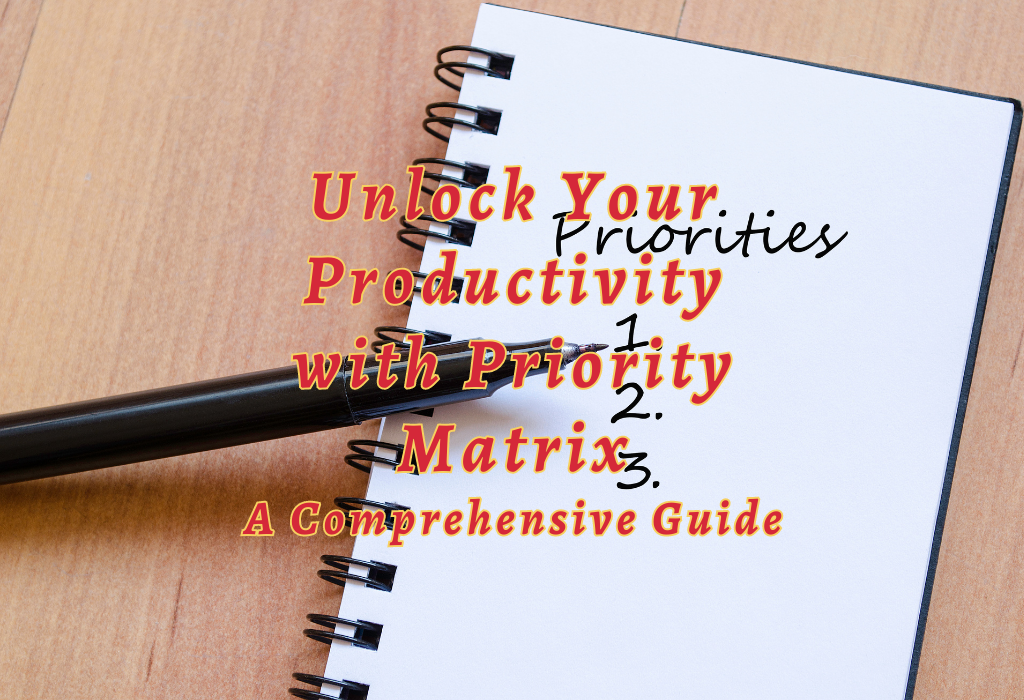Unlock Your Productivity with Priority Matrix: A Comprehensive Guide
Have you ever felt like you have too much on your plate? You’re not alone. Between juggling work, family, and other responsibilities, staying productive and focused can seem like an uphill battle. When your endless list of tasks is stretching out of reach, it’s time to grab hold of the key to unlocking your productivity: a priority matrix.
Ready to start efficiently categorizing your tasks and managing your ever-growing workload? This comprehensive guide will show you how.

What is a Priority Matrix?
A priority matrix is a powerful tool for improving productivity and achieving goals. It is a visual representation of tasks organized by level of importance, effort, and difficulty. With a priority matrix, goal-oriented individuals can identify their highest-priority tasks and develop strategies to complete them efficiently. Additionally, the matrix provides an overview of goals and tasks which helps plan and manage workloads while also providing clarity on what needs to be done first.
How to set up and interpret a priority matrix
Setting up and interpreting a priority matrix is not as difficult as it may seem. Here are some guidelines to help you get started:
- Assign tasks according to the level of priority. Tasks can be assigned by their deadline, importance, or urgency. You can also assign values to each task according to your criteria.
- Set clear boundaries for your matrix. This means determining how many tasks are necessary when they should be completed, and what success will look like.
- Organize tasks into four different sections based on their level of urgency, importance, weight, and complexity. These can be sorted visually with colors and symbols or simply using words like High/Low Priority, Short-Term/Long-term goals, Critical/Less Important tasks, and Simple/Complex tasks.
- Analyze the data in the matrix to help inform decision-making that will maximize productivity and ensure success in meeting goals. Identify patterns in the data so you can create efficient strategies for meeting objectives promptly as well as recognize any areas that need further improvements or modifications.
Interpreting a priority matrix requires careful analysis of the data collected from organizing each task into its respective category. By evaluating this information and recognizing patterns within it, you can better understand where resources should be allocated for maximum productivity and success in achieving goals.
Using a Priority Matrix to Achieve Goals
Utilizing a priority matrix is an ideal way to move forward with achieving goals. By developing a structured plan, you can assess the most important tasks and find an effective way of seeing how these tasks must be completed. A priority matrix will also help set parameters for your goals and establish deadlines, allowing you to focus on the tasks that need your attention the most.
Certain arguments arise when discussing the use of a priority grid as a means of reaching goals. Some suggest it lacks flexibility, as by setting out specific predetermined tasks, there is limited room for diversification and unexpected eventualities that might occur during the project timeline. Others have argued that it fails to consider extraneous factors, such as workplace culture or individual life circumstances, which may influence task decision-making throughout the project’s life cycle.
There is also an argument to be made in favor of applying a rigid structure in prioritization. The grid offers clarity and focuses on tasks that can be completed within an allocated timeline. Goals can thus be achieved more quickly by focusing on singular objectives through deadlines with ample cushioning for unexpected eventualities.
The discussion around using a priority matrix to achieve goals holds both advantages and disadvantages and ultimately depends on individual preference and circumstance.
How to Prioritize Tasks
Prioritizing tasks is an essential component of boosting productivity. Unfortunately, it can be an overwhelming task to decide how to prioritize all of the work required of you, because each task has its level of importance. To effectively prioritize tasks, it is important to understand the different types of priority and determine which ones apply to your situation.
Types of priority include urgency, importance, and significance.
Highlight the visible urgency
Urgency applies when there are deadlines or fast-approaching due dates that require immediate attention. Important tasks are those that have a direct effect on the outcome of a project or aim to achieve long-term goals. Tasks that have the most significant impact on success should be given the highest priority; these are the ones with the greatest potential return on investment (ROI).
Understand the responsibility of factors
To make accurate decisions on task prioritization, it is necessary to weigh all factors such as urgency, importance, significance, resources available, and risk involved in each task. A useful technique for making this determination is called “timeboxing” – assigning time limits for the completion of tasks. This allows you to quickly assess the importance of any given task based on how much time you can commit to it. Through trial and error, you should develop an efficient system for deciding what tasks take precedence over others.
How to Visualize High-Priority Tasks
Visualizing high-priority tasks is a crucial step in utilizing Priority Matrix to its fullest potential. When done correctly, creating a visual representation of the highest-priority tasks can lay the foundation for increased productivity and improved task organization and management. By taking the time to properly understand their importance, we can become more equipped to tackle them one by one until completion.
Manual marking
The most basic way to visualize priorities is by using a simple ‘high priority’ graphic, such as a star or checkmark. With just a glance, you can quickly identify which tasks are the most important and set about working on them first. For those just getting started with task management, this graphic method can be a great way to start forming the habit of prioritization.
Strategic marking
On the other hand, some may argue there is more benefit in strategically planning out priorities based on what needs to be completed in what order. For example, if R&D is an essential part of a project, it would make sense to prioritize it before moving on to any marketing efforts. This approach requires thought and more time spent considering all factors relative to each task.
The bottom line is that finding what works best for you and your workflow is the most important factor when visualizing priorities.
The Benefits of a Priority Matrix
Using a priority matrix to organize tasks and projects is growing in popularity among both business owners and entrepreneurs who need to better manage their workload. The benefits of using a priority matrix are extensive.
Drawbacks
However, some drawbacks may come with using a priority matrix. Time spent setting up the system is time away from actually getting things done, meaning there will inevitably be an initial decrease in productivity until users become familiar with the layout. Additionally, depending on the complexity of the tasks being tracked, this kind of visualization may add more confusion than clarity if it becomes too complex.
Overall, the benefits of utilizing a priority matrix far outweigh any potential drawbacks. By providing greater awareness of project priorities as well as increasing visibility into how team members are impacting each other’s workflows, a priority matrix can be an invaluable addition to anyone who needs to maximize productivity in their workplace.
How to Create a Priority Matrix
When it comes to unlocking your productivity, nothing is more important than the Priority Matrix. This powerful tool is designed to help you quickly and effectively identify and prioritize tasks that need to be completed. The concept is simple: arrange your tasks in a matrix format with two axes, one representing importance and the other representing urgency.
Step#1: listing out
To create a Priority Matrix, simply start by listing out all of the tasks that need to be done. It’s important to consider both long-term goals and shorter-term objectives when making this list; the idea is to get an overall view of what needs to be accomplished for you to reach your desired outcome.
Step #2: categorize
Once all of your tasks have been listed, begin assigning them to a category based on their importance and urgency. Tasks that are deemed important but not urgent should go into the first quadrant, tasks that are both important and urgent should go into the second quadrant, and tasks that are urgent but not important should go into the third quadrant.
Step#3: eliminate
finally, tasks that are neither important nor urgent should go in the fourth quadrant. Doing this will help you get a comprehensive overview of all of your priorities, allowing you to make decisions about how best to allocate your time and resources.
Important things to keep in mind
When deciding how to sort your list of tasks into the Priority Matrix’s four quadrants, it’s important to resist any tendencies toward procrastination. Some people may find themselves putting off certain tasks or becoming overly preoccupied with certain items while neglecting others; it is better to take an honest and realistic assessment of each task’s value rather than using subjective criteria when placing them into certain categories. Additionally, while it can be tempting to tackle all of the urgent tasks first, try not to let this overwhelm you – it is equally as important (if not more so) for productivity purposes for you to stay focused on the important but less urgent items as well.
Now that you understand how creating a Priority Matrix works, let’s move on and explore some alternatives to this useful tool in our next section.
Alternatives to the Priority Matrix
Although Priority Matrix is widely used and is a popular tool to increase productivity, it is not the only option. A wide range of alternative tools exists that can also improve your productivity by helping you organize and prioritize tasks.
Alternate #1:
One such alternative is Trello, which allows users to create boards for different projects and then drag-and-drop cards for individual tasks into columns for completion status. Like Priority Matrix, Trello is easy to use and helps users structure their tasks in an organized manner. It also offers project collaboration tools, which some might prefer. However, even though Trello does have task automation features, it lacks the same degree of sophisticated automation that sets Priority Matrix apart from similar tools.
Alternate #2:
Slack, another popular productivity tool, focuses primarily on communication and collaboration between team members. It provides a central platform that supports voice and video calls as well as instant messaging across multiple channels and direct messages between colleagues. It also integrates with other applications to provide a helpful feed of updates and notifications; however, Slack lacks much of the project management functionality found in Priority Matrix.
Alternate #3:
Lastly, Asana is a task-handling system designed specifically with professional productivity in mind. Its purpose is to help users manage and track the progress of specific projects and report progress back to their teams. Unlike Priority Matrix, Asana offers more advanced views for monitoring milestones or deadlines associated with tasks. However, its free plan does not include many features like collaboration boards that are available in higher plans, leaving businesses with fewer options when deciding which one works best for them.
These alternative tools each have their strengths and weaknesses as compared to Priority Matrix. Ultimately it’s up to businesses to consider their specific needs before deciding which productivity tool will work best for them.
Conclusion
Priority Matrix is an invaluable tool for managing tasks, projects, and priorities conveniently and efficiently. It helps to increase productivity by automatically assigning the highest priority to still open tasks while allowing users to easily access all of their data from one convenient dashboard. The mobile app can be used to keep track of progress even when away from the office, and the cloud-based platform ensures no disruption in services if an individual’s device or system fails.
All in all, Priority Matrix provides an easy-to-use structure that simplifies organization and allows tasks to be completed faster with greater accuracy. It is functional, intuitive, and efficient; perfect for anyone looking to unlock their productivity potential. It is well worth considering if you require a task management tool for your team or business.






